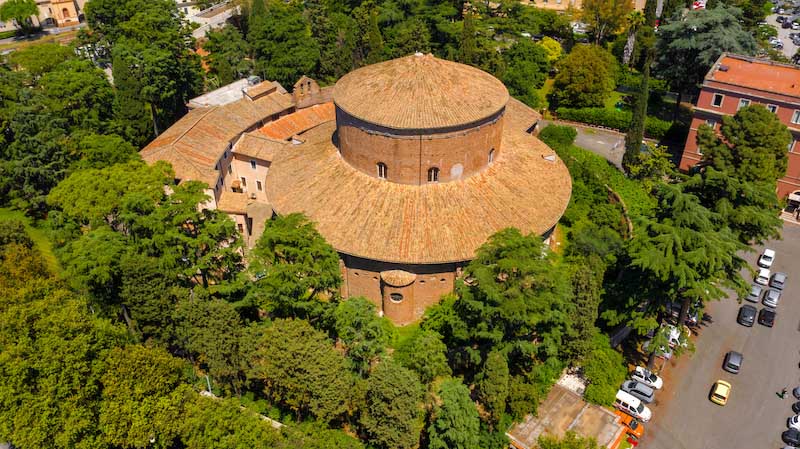If you are in Rome and thinking about a Colosseum Tour, you surely can’t miss a visit to Saint Stefano Rotondo, one of the oldest Christian churches in Rome, that was erected at the time of Pope Simplicius, between 468 and 483.
The basilica, built of rubble, originally had a circular plan but was divided into three concentric naves. The central ring was supported by 22 bare columns, so they were not all the same, especially in height: the tallest one measured about 6 metres, the lowest 5.65, which is why bases of different heights can be seen to remedy this inconvenience.
The capitals, on the other hand, were made and carved during construction, while an altar was placed in the central space, set within an enclosed area. It is preceded by a portico with five arches, on tall ancient granite columns with Corinthian capitals.
Originally, it consisted of a circular room, circumscribed by two concentric ambulatories, formed by two rounds of columns: the outer ambulatory was intersected by the four arms of a Greek cross, at the ends of which were four chapels.
The church is located within a garden and is accessed under one of the vaults of Nero’s extension of the Claudian aqueduct, which is surrounded by Roman walls.
The history of the Church from the 12th century
In the 12th century, Pope Innocent II ordered the addition of the entrance portico and the three grandiose transverse arches of the inner area, using two very tall granite columns to support the crumbling roof.
In 1453, Pope Nicholas V had the church renovated by reducing its diameter. The majestic interior consists of a ring of twenty-two fine marble columns separating a large central area, creating two circular walkways around the high altar in the centre of the church.
Originally there was a third concentric ambulatory with a cruciform internal division dismantled during the 15th-century restorations.
The eight-sided balustrade is decorated with paintings depicting episodes from the life of Saint Stephen by Antonio Tempesta (1580).
Another noteworthy feature of this church is the Martyrology Cycle, a series of thirty-four frescoes along the peripheral wall of the church, painted by Pomarancio and Matteo da Siena (1582). The first chapel on the left, dedicated to Saints Primo and Feliciano, contains some Byzantine mosaics dating back to the 7th century AD depicting Christ on an uncrossed gemmed cross, according to an ancient iconographic scheme between Saints Primo and Feliciano. A small head of Christ appears on the upper end of a brilliantly decorated cross. The walls of the chapel are covered with frescoes by Antonio Tempesta (1568).



